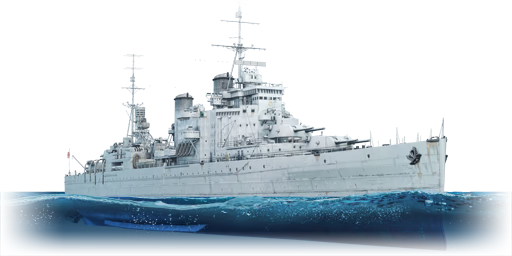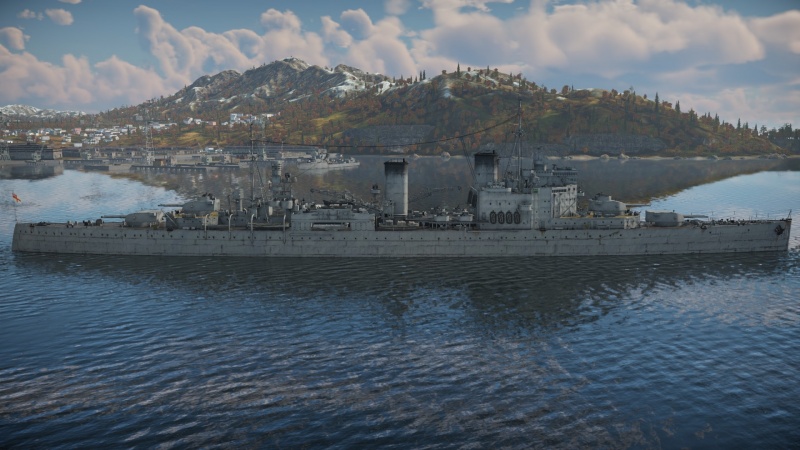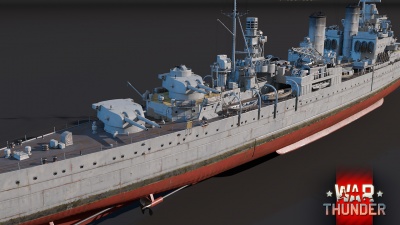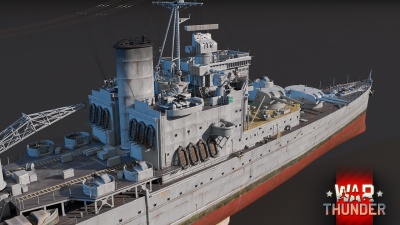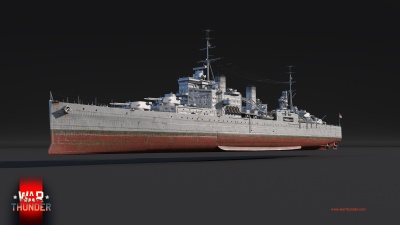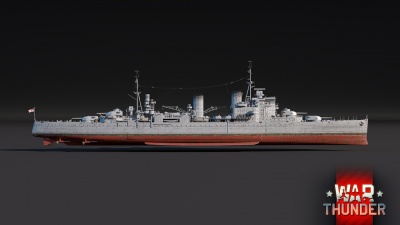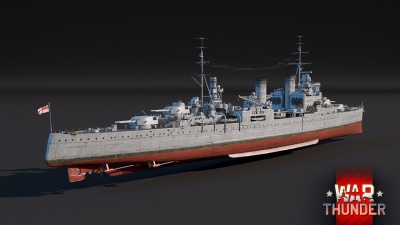HMS London
Contents
Description
The County-class, HMS London (69), 1945 is a rank IV British heavy cruiser with a battle rating of 5.7 (AB/RB/SB). It was introduced in Update 1.97 "Viking Fury".
General info
Survivability and armour
Talk about the vehicle's armour. Note the most well-defended and most vulnerable zones, e.g. the ammo magazine. Evaluate the composition of components and assemblies responsible for movement and manoeuvrability. Evaluate the survivability of the primary and secondary armaments separately. Don't forget to mention the size of the crew, which plays an important role in fleet mechanics. Save tips on preserving survivability for the "Usage in battles" section. If necessary, use a graphical template to show the most well-protected or most vulnerable points in the armour.
Mobility
Write about the ship's mobility. Evaluate its power and manoeuvrability, rudder rerouting speed, stopping speed at full tilt, with its maximum forward and reverse speed.
| Mobility Characteristics | |||
|---|---|---|---|
| Game Mode | Upgrade Status | Maximum Speed (km/h) | |
| Forward | Reverse | ||
| AB | |||
| Upgraded | 70 | 29 | |
| RB/SB | |||
| Upgraded | 60 | 25 | |
Modifications and economy
Armament
Primary armament
Provide information about the characteristics of the primary armament. Evaluate their efficacy in battle based on their reload speed, ballistics and the capacity of their shells. Add a link to the main article about the weapon: {{main|Weapon name (calibre)}}. Broadly describe the ammunition available for the primary armament, and provide recommendations on how to use it and which ammunition to choose.
Secondary armament
Some ships are fitted with weapons of various calibres. Secondary armaments are defined as weapons chosen with the control Select secondary weapon. Evaluate the secondary armaments and give advice on how to use them. Describe the ammunition available for the secondary armament. Provide recommendations on how to use them and which ammunition to choose. Remember that any anti-air armament, even heavy calibre weapons, belong in the next section. If there is no secondary armament, remove this section.
Anti-aircraft armament
An important part of the ship's armament responsible for air defence. Anti-aircraft armament is defined by the weapon chosen with the control Select anti-aircraft weapons. Talk about the ship's anti-air cannons and machine guns, the number of guns and their positions, their effective range, and about their overall effectiveness – including against surface targets. If there are no anti-aircraft armaments, remove this section.
Additional armament
Describe the available additional armaments of the ship: depth charges, mines, torpedoes. Talk about their positions, available ammunition and launch features such as dead zones of torpedoes. If there is no additional armament, remove this section.
Usage in battles
Describe the technique of using this ship, the characteristics of her use in a team and tips on strategy. Abstain from writing an entire guide – don't try to provide a single point of view, but give the reader food for thought. Talk about the most dangerous opponents for this vehicle and provide recommendations on fighting them. If necessary, note the specifics of playing with this vehicle in various modes (AB, RB, SB).
Pros and cons
Pros:
- Very effective anti-air defences
- 8 inch guns are useful for sinking cruisers and destroyers
- Ammunition is stored under the water line and is well protected
- Carries torpedoes which are useful in close range encounters
- Decent speed for a heavy cruiser
Cons:
- Guns lack AP shells to deal with battlecruisers and battleships
- No bridge protection, losing control is very common in this ship
- Lacks deck armour against plunging shells
- Armour is weak against battleship-calibre guns
- Outgunned by battleships, battlecruisers, and some American heavy cruisers
History
The Treaty Cruiser
The 1921 Washington Treaty conference aimed to prevent war between the major naval powers by restricting warship construction. It decided that cruiser displacement should be limited to a maximum of 10,000 tons per ship. Britain had set the pace by constructing the Hawkins Class – the most modern and capable cruisers of their time – which displaced close to 10,000 tons. It was known that the USA and Japan would soon match, and probably exceed, them, building 10,000-ton cruisers with 8-inch guns (the Hawkins Class ships carried 7.5-inch main guns). The British answer was heavy cruisers of the County Class, constructed in three batches that were to be armed with 8-inch guns and would be fast with long-range. At the end of 1923, the British administration gave the building of eight County Class cruisers known as Kent class (Kent, Suffolk, Cumberland, Berwick, and Cornwall) with two extras (Australia and Canberra) for the Royal Australian Navy. They were laid down between July 1924 and September 1925 and completed between July 1927 and July 1928. Next came the London Class (London, Devonshire, Shropshire, and Sussex), laid down between March 1926 and February 1927 and completed between January and September 1929.
The most obvious difference between the London Class and the Kent was removing a protective bulge on the waterline, which forced a modified hull design that increased length by two feet eight inches and incorporated internal bulges. Their high freeboard meant they were, in most weather, dry ships and could keep up a good rate of knots even in heavy seas. The beam of the Kent was two feet five inches wider than the London. HMS London's displacement was 9,850 tons (standard) and 13,315 tons (full load). She was 632 feet 8 inches in length, with a sixty-six-foot beam and a draught of twenty feet nine inches. Propulsion was provided by Parsons geared turbines and eight Admiralty three-drum boilers. HMS London could carry 3,190 tons of oil and achieve more than thirty-two knots. In addition to eight 8-inch main guns and four 4-inch-high angles, secondary London had four 2-pounder guns and eight 21-inch torpedo tubes. The bridge and the foremast of the London Class cruisers were set further aft to allow B turret to fire 'abaft the beam without blasting the bridge.
HMS London in the 1930s
For her first overseas deployment, HMS London was sent to the Mediterranean, where she became the flagship of the First Cruiser Squadron and activated in the following years. Trouble was brewing on the island of Cyprus in the early 1930s and soon boiled over into insurrection. It had been granted Crown Colony status in 1925, after being taken from the Turks and occupied by British forces in the First World War. Its position in the eastern Mediterranean made it an ideal base from which to provide additional security for British interests in the Middle East, such as the Suez Canal and Palestine. A strategically vital oil pipeline terminated at Haifa, and the island was also an important staging post for travelers heading to Britain's empire in Asia. Having cast off the hated Turks, Greek Cypriots were angry and frustrated at being prevented by British rule from uniting with their ethnic homeland of Greece. A decision by the Crown Colony administrators to raise taxes stoked the fires of resentment. On 21 October 1931, a mob gathered and marched on the Governor's residence. They burned it to the ground and then went on the rampage when the police belatedly intervened.
The Royal Navy was asked to aid the civil powers, with HMS London and her sister ship HMS Shropshire sent to suppress the uprising in company with the destroyers HMS Acasta and HMS Achates. At Larnaca, HMS London landed armed shore parties of Royal Marines and sailors to protect government offices. They found the local population still defiant and capable of violence. The protestors hurled verbal abuse at London's marines and matelots, waving the Greek flag in their faces. Stones rained down on the helmets of the British, but they held firm. The rioters were trying to make the marines and sailors lose their cool and open fire in the hope that Greece might protest and even intervene militarily. In the early hours of 25 October, the revolt leaders were arrested by troops and police. They were taken by boat to London and Shropshire, where they were held in the cruisers' wardrooms' convivial surroundings. The detainees were given every hospitality, including good food and drink. A few stiff whiskies helped steady the nerves of those still a little shocked at being hauled from their beds in the wee small hours. The seizing of the leaders took the steam out of the revolt, and the British warships were soon able to quit the island's harbors, leaving a job well done behind them.
On 18 July 1936, the Fascist General Franco led an uprising by twelve military garrisons on mainland Spain and five in Spanish Morocco. Most of southern Spain fell to the Fascists, and outside forces intervened to stoke the fires of conflict – the Germans and Italians on the Fascist side and Russia on the Republican government side. Thousands of British passport holders were at the mercy of various warring factions, and the UK government responded by sending warships, including HMS London, to evacuate them from danger, using Barcelona and Valencia as points of embarkation. The ship stopped at Malta for supplies and then went on to Barcelona in company with the Devonshire. On 22 July, the cruiser was secured by her stern to the Mole in Barcelona harbor and the ship received reports from ashore saying the city was now quiet after savage fighting.
The Quote template is used to highlight quotes in a text.
Use
{{Quote
|Quote text
|Source, author (optional parameter)
}}
Examples of use
|
There’s no harm in hoping for the best as long as you’re prepared for the worst. <...>
|
As London waited for the evacuees to start arriving, the situation grew more volatile. On 23 July, a bomb from an aircraft landed near a British warship patrolling the Straits of Gibraltar. HMS London was informed that Barcelona's British Colony of 1,000 people, including many nuns, was to be evacuated. By midnight on 23 July, only 200 people had turned up, with forty of them being immediately sent to Marseilles aboard the destroyer HMS Douglas, which had come alongside London to take them off.
At the beginning of August, the Italian and Swiss governments ordered all their nationals out of Spain. London was flooded with desperate people, and Commander Wright gave up his cabin to a refugee family, ending up sleeping on the upper deck by X-turret. London was told on 7 August that she would stay another fifteen days in Barcelona. After returning to Gibraltar, she was to head back to Portsmouth for a refit that was due to commence in November, during which she was to receive four more high-angle 4-inch guns. By mid-August, it was apparent to Captain Wright that an increasing number of the 'British' refugees were bogus:
The Quote template is used to highlight quotes in a text.
Use
{{Quote
|Quote text
|Source, author (optional parameter)
}}
Examples of use
|
There’s no harm in hoping for the best as long as you’re prepared for the worst. <...>
|
On 22 August, HMS London was pleased to note that HMS Shropshire had arrived in Barcelona to relieve herself. Between 23 July and 29 July, 839 refugees were evacuated via HMS London, and a further 1,000 were sent to safety between 30 July and 21 August.
At the end of 1936, HMS London was tasked with hunting down gunrunners in Western Mediterranean. Her aircrafts located a suspicious-looking vessel that could well have been a gunrunner, but the cruiser caught up after five hours of hard steaming, only to discover that it was not the suitable quarry at all. In 1937 HMS London was called back to Britain for celebrating the coronation of King George VI and another major refit.
Devblog
The County-class cruisers, also known as the A-Type cruisers, were the first British cruiser vessels to be developed in the interwar period of the 1920s. Their design being heavily influenced by the restrictions imposed by the Washington Naval Treaty, meant that British shipbuilders had to find compromises during development in order to comply with the treaty as well as to meet the requirements of the Royal Navy for a ship capable of trade route protection.
This resulted in the creation of a ship design with good cruising range and adequate firepower, but very light armour protection in order to stay within treaty restrictions. The orders for the first ships were placed in the mid 1920’s and construction began in 1924.
HMS London (C69) was laid down in February 1926 and commissioned into service in January 1929 as the lead ship of the second batch of County-class cruisers to be built, known as the London subclass. During the 1930’s, HMS London took part in a goodwill visit to Venice and assisted in the evacuation of civilians from Barcelona during the Spanish Civil War, before being sent to drydock for refit in 1939.
In 1941, HMS London took part in the hunt for the battleship Bismarck, after which the ship was once again dry-docked for repairs. The following year, HMS London assisted in escorting several convoys in the Atlantic, after which she was assigned to South African waters in 1943, before joining the Eastern Fleet. HMS London continued serving in the postwar years, during which the ship got involved in an incident in Chinese waters in 1949 which left it heavily damaged. Being deemed uneconomical for repairs, HMS London was sold for scrap in January 1950.
Media
See also
Links to articles on the War Thunder Wiki that you think will be useful for the reader, for example:
- reference to the series of the ship;
- links to approximate analogues of other nations and research trees.
External links
References
Works Cited
- Ballantyne, I. (2002). HMS London: Warships of the Royal Navy. Casemate Publishers.
- Beesly, P. (1990). Convoy PQ 17: A study of intelligence and decision‐making. Intelligence and National Security, 5(2), 292-322.
- Brown, D. K. (2012). Nelson to Vanguard: Warship Design and Development 1923 1945. Seaforth Publishing.
- Colledge, J. J., & Warlow, B. (2010). Ships of the Royal Navy: The complete record of all fighting ships of the Royal Navy from the 15th century to the present. Casemate/Greenhill.
- Irving, D. J. C. (1968). The Destruction of Convoy PQ. 17. Cassell
| Britain heavy cruisers | |
|---|---|
| Hawkins-class | HMS Hawkins |
| York-class | HMS York |
| County-class | HMS Kent · HMS London · HMS Norfolk |


